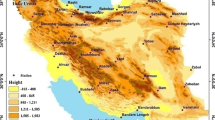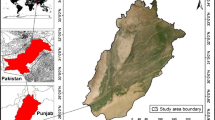Abstract
This study investigates the spatial and temporal variations of the aridity indices to reveal the desertification vulnerability of Iraq region. Relying on temperature and precipitation data taken from 28 meteorological stations for 31 years, the study aims to determine (1) dry land types and their delineating boundaries and (2) temporal change in aridity conditions in Iraq. Lang’s aridity (Im), De Martonne’s aridity (Am), United Nations Environmental Program (UNEP) aridity (AIu), and Erinç aridity (IE) indices were selected in this study because of the scarcity of the observed data. The analysis of the spatial variation of aridity indices exhibited that the arid and semi-arid regions cover about 97% of the country’s areas. As for temporal variations, it was observed that the aridity indices tend to decrease (statistically significant or not) for all stations. The cumulative sum charts (CUSUMs) were applied to detect the year on which the climate pattern of aridity indices had changed from one pattern to another. The abrupt change point was detected around year 1997 for the majority of the stations. Thus, the spatial and temporal aridity characteristics in Iraq were examined for the two periods 1980–1997 and 1998–2011 (before and after the change-point year) to observe the influence of abrupt change point on aridity phenomena. The spatial variation after 1997 was observed from semi-arid (dry sub humid) to arid (semi-arid) especially at the stations located in northern Iraq, while hyper-arid and arid climatic conditions were still dominant over southern and central Iraq. Besides, the negative temporal variations of the two periods 1980–1997 and 1998–2011 were obtained for almost every station. As a result, it was emphasized that Iraq region, like other Middle East regions, has become drier after 1997. The observed reduction in precipitation and increase in temperature for this region seem to make the situation worse in future.




Similar content being viewed by others
References
Abdulla HJ (2008) Evaluation of moisture deficit index in dry land in Iraq. Middle-East J Sci Res 3(3):116–119
Baltas E (2007) Spatial distribution of climatic indices in northern Greece. Meteorol Appl 14:69–78
De Martonne E (1926) Aerisme, et índices d’aridite. Comptesrendus de l’Academie des Sciences 182:1395–1398
Deniz A, Toros H, Incecik S (2011) Spatial variations of climate indices in Turkey. Int J Climatol 31:394–403
Elagib A, Addin Abdu S (1997) Climate variability and aridity in Bahrain. J Arid Environ 36:405–419
Erinç S (1996) Klimatoloji ve Metodları. Alfa Basic-Yayım-Dağıtım, Istanbul
Haider S, Adnan S (2014) Classification and assessment of aridity over Pakistan provinces (1960-2009). Int J Environ 3(4):24–35
IPCC (2007) Climate change 2007: climate change impacts, adaptation and vulnerability. Working Group II contribution to the Intergovernmental Panel on Climate Change Fourth Assessment Report. Summary for policymakers, 23
Lang R (1920) Verwitterung und Bodenbildung als Einführung in die Bodenkunde. Schweizerbart Science Publishers, Stuttgart
Lungu M, Panaitescu L, Niţă S (2011) Aridity, climatic risk phenomenon in Dobrudja. Present Environ Sustain Dev 5(1):179–190
Mahmood Agha OM, Şarlak N (2016) Spatial and temporal patterns of climate variables in Iraq. Arab J Geosci 9(4):1–11
Önder D, Aydin M, Berberoğlu S, Önder S, Yano T (2009) The use of aridity index to assess implications of climatic change for land cover in Turkey. Turk J Agric For 33(3):305–314
Paltineanu C, Tanasescu N, Chitu E, Mihailescu IF (2007) Relationships between the De Martonne aridity index and water requirements of some representative crops: a case study from Romania. International Agrophysics 21(1):81
Penman H (1948) Natural evaporation from open water, bare soil and grass. Proc R Soc A 193:120–146
Sen PK (1968b) On a class of aligned rank order tests in two-way layouts. AMS 39:1115–1124
Some’e BS, Ezani A, Tabari H (2013) Spatiotemporal trends of aridity index in arid and semi-arid regions of Iran. Theor Appl Climatol 111:149–160
Subyani A, Al-Modayan A, Al-Ahmadi F (2010) Topographic, seasonal and aridity influences on rainfall variability in western Saudi Arabia. J Environ Hydrol 18:1–11
Tabari H, Talaee PH, Nadoushani SSM, Willems P, Marchetto A (2014) A survey of temperature and precipitation based aridity indices in Iran. Quat Int 345:158–166
Talaee PH, Some’e BS, Ardakani SS (2014) Time trend and change point of reference evapotranspiration over Iran. Theor Appl Climatol 116(3–4):639–647
Thornthwaite CW (1948) An approach towards rational classification of climate. Geogr Rev 38:55–64
Turkes M (1999) Vulnerability of Turkey to desertification with respect to precipitation and aridity conditions. Turk J Eng Environ Sci 23:363–380
UNEP (1992) World atlas of desertification. Edward Arnold, London
UNESCO (1979) Map of the world distribution of arid regions. Explanatory note, Man and Biosphere (MAB)
Yenigun K, Gumus V, Bulut H (2008) Trends in streamflow of the Euphrates basin, Turkey. Proc ICE—Water Manag 161(4):189–198
Author information
Authors and Affiliations
Corresponding author
Rights and permissions
About this article
Cite this article
Şarlak, N., Mahmood Agha, O.M.A. Spatial and temporal variations of aridity indices in Iraq. Theor Appl Climatol 133, 89–99 (2018). https://doi.org/10.1007/s00704-017-2163-0
Received:
Accepted:
Published:
Issue Date:
DOI: https://doi.org/10.1007/s00704-017-2163-0




